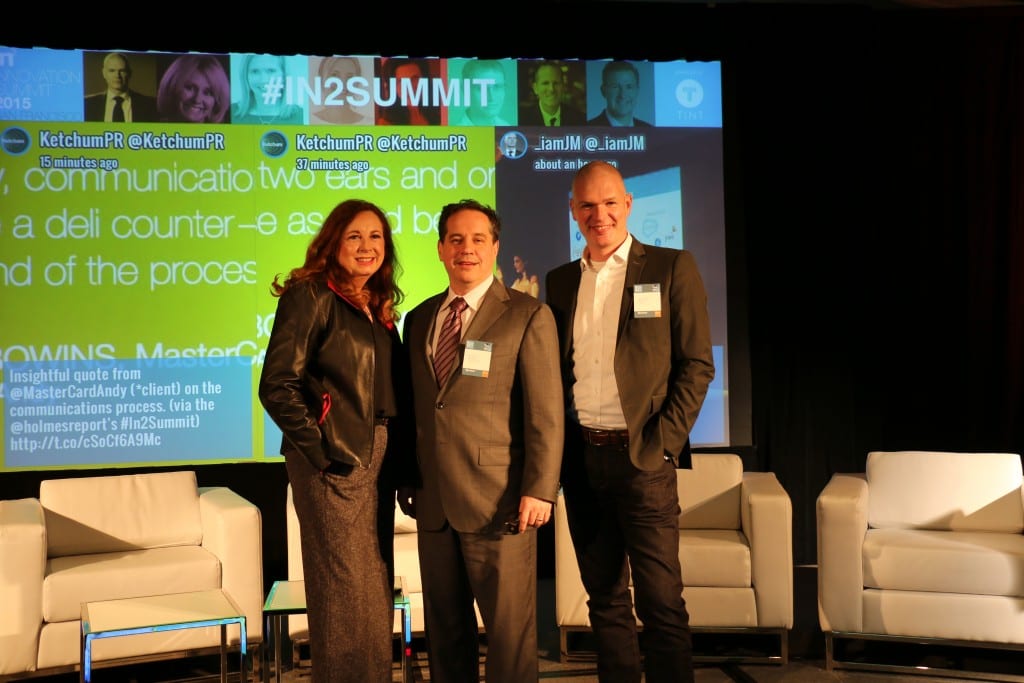 This was one of those weeks that reminded me why I love my job so much. In my new role as Global Tech Director for Ketchum, I had the opportunity to moderate a thought-provoking session at Holmes In2 Innovation Summit at the Ritz Carlton, San Francisco. The session, “How to Future Proof Your Brand,” focused on how the social web and integrated communications are redefining the ways in which brands connect with their target audiences.
This was one of those weeks that reminded me why I love my job so much. In my new role as Global Tech Director for Ketchum, I had the opportunity to moderate a thought-provoking session at Holmes In2 Innovation Summit at the Ritz Carlton, San Francisco. The session, “How to Future Proof Your Brand,” focused on how the social web and integrated communications are redefining the ways in which brands connect with their target audiences.
I was joined by Andrew Bowins, Senior Vice President of Corporate Reputation and Engagement for MasterCard (*client), and Jonathan Martin, the Chief Marketing Officer for EMC. While they are in very different industries, they both agree that marketing is going through the biggest change it has seen in a century, and the distinction between B2B and B2C for marketers needs to be forgotten — as today everyone is a consumer. Furthermore, the notion that a brand can control what is being said about it is dated — it just isn’t possible anymore. The Holmes Report captured an excellent summary of the session and I’d like to build on it with three additional insights.

1. Content Pollution
Keeping in mind that every 60 seconds 1,500 blogs are posted, Facebook users share nearly 2.5 million pieces of content, Twitter users tweet nearly 300,000 times and YouTube users upload 72 hours of new video — the sheer volume of content being produced by people, brands and publishers is creating an era of what Bowins describes as “content pollution.” This makes it critical for brands to carefully listen to what people are talking about on the social web and then evaluate how to meaningfully engage in conversations with the right audiences.
MasterCard’s solution to this has been to instill a philosophy of “listening twice as much as we are talking” and to develop the MasterCard Conversation Suite – an engagement platform complete with values and metrics to analyze conversations. As Martin noted, “The best content inspires, educates or makes people laugh (click to tweet). If you’re not doing one of those items, your content will fail.” Creating content and an engaging narrative have always been the heart of public relations, but public relations professionals need to have a wider definition and wider set of skills. Today they need to know about big data, metrics, content creation, digital, and social.
2. Breaking Down Silos
Martin and Bowins provided excellent insights about how we need to reframe structure to achieve success. Both agree the silos that exist between marketing, public relations and digital need to come down and operate holistically. The companies who are doing it right have moved beyond the turf wars and are fully integrated and working as one team. Furthermore, Bowins recommended that public relations step up and take a leadership role and not be bullied by their marketing counterparts, which typically have larger budgets and bigger teams. He warned, “We are in a Golden Age for communications but are dangerously close to messing it up if we don’t adapt to changing landscapes.”
3. Measure for Value, Not Volume
In the wider world of content reach and amplification there are always questions about how to measure for value, instead of just measuring for volume. Brands need to get much better at understanding who is consuming their content, along with when and how they’re doing so. There is no point in producing a ton of content and throwing it out there without a clear idea on who the target audience is and where they live online.
As Martin said, “A volume metric without insight lacks credibility. So moving forward instead of measuring tweets and likes, we should be assessing what the data means to the business, identifying data that confirms that a brand is effectively interacting with key influencers and that brand messages are resonating within conversations.”
We know that a company’s brand is its most important asset, yet at the same time it is its most fragile (click to tweet). We live in a Moore’s Law world of communications — where twice as many influencers seem to have twice as much impact on brands in half as much time. The days of controlling a brand are over, but through collaboration between marketing and communications teams who are committed to careful listening, relevant and engaging content and meaningful metrics, we can help to build strong and sustainable brands.


